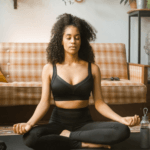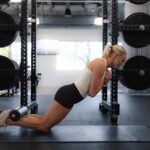Disclosure:
Thank you for reading this post, don't forget to subscribe!
Some of the links on this website are affiliate links. This means that if you click on the link and make a purchase, we may receive a small commission at no extra cost to you. Your support helps us keep the site running.Learn more on my Privacy Policy and Affiliate Disclosure page. Thank you for your support!

Fitness used to be all about pumping iron and running till you dropped. It was gritty, sweaty, and iron-clad, literally. For decades, the focus stuck mainly to the physical grind—muscle building, hardcore cardio, and the relentless pursuit of a chiseled physique. But things change, right? And in the world of fitness, they’ve changed big time.
Holistic fitness has made quite the entrance, shaking up the old-school regime and bringing a more balanced vibe. So, what’s this shift about? It’s more than just the workout. It involves getting the body, mind, and spirit aligned. People are not just looking to be fit; they want to feel good inside out. It’s like the difference between wearing a tuxedo that just fits versus one that’s tailor-made for your body.
So, what’s pushing this shift? For some, it started with the realization that mental wellbeing is as crucial as, say, your abs showing up when you flex. Plus, the fast-paced world where stress levels are through the roof means folks are hunting for more than just physical health. They’re seeking ways to soothe their minds too. It’s about finding calm amidst the chaos while still getting those gainz.
learn more about: oaks integrated care-The Importance of Integrated Health and Wellness.
The rise of social media influencers, wellness gurus, and celebrities touting a holistic lifestyle plays a massive role too. When your favorite pop star shares their meditation routine or an athlete credits their success to balancing mental and physical health, it naturally piques interest. When you scroll through your feed, it isn’t all about high-intensity workouts anymore. Breathing exercises, yoga flows, and mindful eating have joined the chat.
Holistic fitness isn’t just a buzzword. It’s reshaping how we think about health, moving away from the one-size-fits-all model to something far more inclusive and adaptable. We’re talking about a shift from gym memberships being the end-all-be-all, to folks exploring outdoor activities, meditation apps, and even group fitness that caters to different facets of health. It’s like rather than changing just the car’s engine, we’re now looking at the whole dang vehicle—inside and out.
related: Daily Fitness Routine for Busy Professionals – Stay Active and Healthy.
Considering all these factors, it’s clear why holistic fitness isn’t going anywhere anytime soon. It’s become a part of the everyday conversation around health, appealing to people of all ages and backgrounds. Whether you’re all in or just dipping your toes in the water, embracing holistic fitness is about a better, more balanced you—for today and the future.
Exploring Holistic Fitness
Holistic fitness is about tuning into a broader spectrum of well-being that includes the mental, emotional, and physical aspects. The definition might feel a bit broad, but that’s because it embraces a whole-self approach to fitness. Now, it’s not just about how fast you can run or how much you can lift. It’s also about mental clarity, emotional resilience, and even finding joy in the process.
Traditional fitness often focuses on physical achievements, like that killer squat PR or crossing the marathon finish line. Holistic fitness dives deeper, looking at how these achievements affect—and are affected by—your mental state. It’s about recognizing how interconnected our systems are. The workout itself becomes just one part of a larger puzzle, where peace of mind and body alignment matter just as much.
read more about: The Top 10 Exercises-For Improving Men’s Health And Wellness.
Why make the switch? Well, incorporating wellness practices into your fitness routine boasts some solid perks. Reduced stress, enhanced self-awareness, and improved overall health are just the tip of the iceberg. When the mind feels as good as the body, there’s a boost in motivation, better recovery, and even longevity in maintaining a fitness lifestyle. It’s like nurturing a plant: when you water it properly, it thrives.
Holistic fitness blends ancient wisdom with modern science. Practices such as meditation, yoga, and mindful breathing are here to back up your squats and sprints with layers of wellness. It’s like you’ve added the best supporting cast to your fitness journey, ensuring you aren’t just reaching your goals, but also enjoying the ride there. Breathing exercises, mindful movements, and nutritional mindfulness are key players in keeping the body and mind in sync.
Find out more about: NCCIH-Complementary, Alternative, or Integrative Health.
Shifting to a holistic approach doesn’t mean overhauling your life overnight. Start small. Pick one new practice that intrigues you. Maybe swap a cardio session with a yoga class or try a five-minute meditation. The idea is to experiment and find what vibe strikes a chord with you. Remember, it’s not about perfect balance every day—it’s about showing up with an open mind to different dimensions of health.
Core Components of Holistic Fitness

Physical fitness isn’t just about lifting weights or running; it’s intertwined with mental well-being. Engaging in regular exercise releases endorphins, those feel-good hormones that can lift your mood and alleviate stress. Ever felt that high after a good workout? That’s what I’m talking about! It’s about feeling like you could take on the world, with all cylinders firing.
Nutrition plays a starring role in holistic fitness. Think of your body as a high-performance machine—give it premium fuel, and it runs smoother. Eating mindful, balanced meals can significantly impact your energy levels, mood, and overall health. It’s not just about cutting out the junk but incorporating wholesome foods that nourish you from the inside out. We’re talking about those leafy greens and nuts, not just plain pasta and bread—think colorful plates bubbling with nutrients.
Mindfulness practices such as yoga and meditation serve as the glue in holistic workouts, connecting body and mind. Yoga isn’t just about twisted poses; it’s also about the breath, the quiet moments that let you center yourself. Meditation works similarly by providing mental space to decompress. These practices promote mental clarity and stress reduction, which feed back into better physical performance.
Incorporating these core components doesn’t require you to flip your already busy life upside down. Think more about layering these practices into your existing routine. Maybe start your day with five minutes of light stretches and deep breathing or swap a high-impact activity for a yoga session once a week. Small tweaks can lead to big changes over time and have you feeling balanced and refreshed.
read next:
- Work-Life Balance: 7 Wellness Tips to Avoid Burnout (2024 Guide)
- 10 Essential Wellness Habits for a Healthier, Happier Life
Incorporating Wellness Practices into Workout Routines
Blending wellness and fitness can be both refreshing and rewarding. Imagine starting your workout with a few minutes of mindfulness to clear your head, effectively setting the stage for a more focused session. Whether it’s simple breathwork between exercises or a soothing cool down with a bit of yoga, incorporating these practices is easier than you might think.
One of the most accessible methods is integrating short meditation sessions into your routine. It doesn’t need to be complex. You can just find a quiet spot, close your eyes, and focus on your breath for a few minutes. This can recalibrate your mindset and enhance your exercise experience. Plus, it’s a great way to wind down and reflect after an intense workout.
Ever tried Tai Chi? This practice combines fluid movement with deep breathing, promoting relaxation while building strength and flexibility. It’s an excellent way to incorporate movement that doesn’t feel like a traditional workout but still delivers results.
Think Pilates might be your thing? This practice is fantastic for building core strength, improving posture, and cultivating body awareness. It’s well-suited for those who prefer low-impact exercises that create lean muscle and enhance flexibility.
Real-life stories can be particularly inspiring. Take the example of Sarah, a busy professional who struggled with stress and finding time for herself. She began integrating short yoga sessions into her routine and noticed significant improvements in her energy and focus. Or Mark, who found the combination of weight training and mindfulness practices kept him centered and motivated through his fitness journey. These aren’t just success stories but examples of how holistic fitness can enrich lives.
The key to successfully mixing wellness with your workouts is to experiment and stay adaptable. There isn’t a one-size-fits-all approach, so give different practices a spin and find out what resonates with you. It’s about creating your own unique wellness routine that evolves with your lifestyle.
Challenges and Misconceptions in Holistic Fitness
Holistic fitness, despite its growing popularity, has its fair share of challenges and misconceptions that can trip people up. One of the biggest misconceptions out there is that it’s only for those who can manage super zen lifestyles, or it’s just a fancy way of saying “less intense workouts.” Couldn’t be further from the truth.
A complete holistic fitness routine can be as challenging and results-driven as any traditional workout plan. It’s about balance and not just scaling back intensity. So, don’t be fooled into thinking it’s a softer or less impactful option.
explore more:
Another common misconception is that you have to become a full-fledged yogi or meditate for hours to experience the benefits. It’s not about dedicating endless time in silence but rather about making small, impactful changes that fit into your daily life. It’s like mindfulness on a diet—tailor it to your needs.
Transitioning to a holistic approach can bring up challenges, like adjusting your mindset from focusing solely on physical goals to embracing a broader spectrum of wellness. Every beginning is messy, right? It might take time to find the right balance between physical exertion and mental peace, but that’s part of the journey.
A major challenge people face is impatience, expecting quick results typical of crash diets and intense workout programs. But holistic fitness is more like a marathon, not a sprint. It requires a shift in how success is measured—from quick fixes to sustainable, long-term health benefits.
It’s also important to address the myth that holistic fitness is too complicated or not suitable for everyone. The reality? It’s adaptable and can be integrated into any lifestyle, whether you’re a gym junkie or just starting out.
Clarity and myth-busting can help people see that it’s accessible and not some exclusive fitness niche. Sometimes, all it takes is a bit of curiosity and willingness to try something new. Educating yourself and finding a community that resonates with this approach can make a world of difference.
The Future of Fitness: Embracing Holistic Approaches
The fitness landscape is evolving, and holistic approaches are undeniably leading the charge. With more people recognizing the interconnectedness of health dimensions, the sector is ripe for innovation. Traditional workout regimes are becoming more enriched as individuals understand the empowering effect of combining physical exercise with mental and emotional care.
A significant trend in the future of holistic fitness is the integration of technology. From apps that guide meditation to wearable devices that monitor not just physical activity but stress levels and sleep quality, tech is making holistic fitness more accessible. These tools provide personalized guidance, helping individuals track their progress across all wellness dimensions. It’s like having a personal wellness coach right in your pocket.
Group fitness classes are also adapting, offering sessions that blend fitness with mindfulness practices. Think high-energy workouts that end with guided meditation or group yoga sessions that incorporate breathwork and mindfulness. These kinds of hybrid classes appeal to people seeking more profound experiences and community connections.
There’s a growing opportunity for innovation as new generations demand more than a sweat session. They’re looking for experiences that offer fulfillment on multiple levels, turning workouts into holistic lifestyle rituals. Fitness studios and gyms that embrace this want will find unique ways to tailor offerings that prioritize mental and physical well-being equally.
For individuals, the emerging trend is all about creating a personal fitness journey that embraces holistic principles. The future doesn’t only belong to cutting-edge tech and adaptable classes; it’s about cultivating an environment that nurtures all aspects of health, fostering resilience, joy, and wellbeing. Ultimately, it’s a shift towards living better rather than just longer.
MORE ABOUT:
HEALTH / WELLNESS / FITNESS / NUTRITION
SHARE THIS ARTICLE











